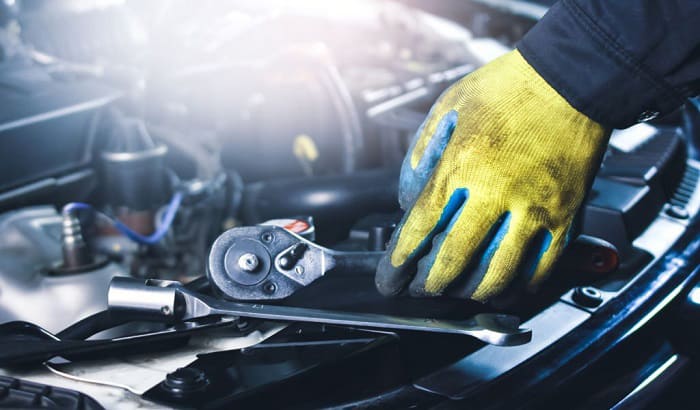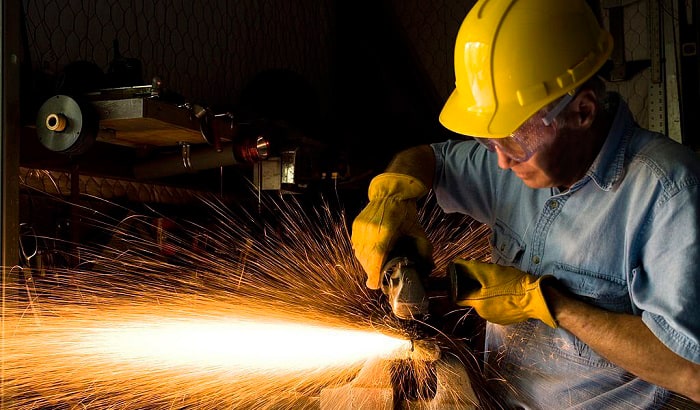Safety gloves are vital during many hazardous procedures, but not when using power tools. The OSHA strictly prohibits the wearing of gloves when workers operate moving machines.
Thus, the answer to “What type of gloves is recommended when using moving machinery” is that you shouldn’t wear any hand protection during such procedures.
Besides, you must follow other regulations, such as taking off rings and bracelets, only using close-fitting PPEs, and tying your hair neatly.
In this article, we will explain the OSHA guidelines, why you should not wear gloves around powered rotating equipment and other related rules. Read below!
Table of Contents
What Type of Gloves Should Be Worn Near Moving Machinery?
1. Gloves are not always appropriate
Gloves keep our hands from cuts, punctures, temperature changes, and bruises. Even a thin pair of disposable gloves can protect against various types of chemicals, infections, and contamination.
However, it is a misconception that gloves should be worn near moving machinery. Hand protection, when used in inappropriate situations, causes more harm than good. You should avoid gloves when working closely with large machinery that has heavy moving or rotating parts. The handwear might get tangled and pull your hands into the machine.
In some specific cases, workers can put on gloves when operating power tools. However, the gloves must fit snugly and allow maximal dexterity.
2. OSHA guidelines
In the U.S. Postal Service handbooks, the OSHA gloves and rotating equipment rules are published as follows:
- You shouldn’t wear hand protection when operating running machines (e.g., feeder, induction, transport conveyor path, drill, chain drive, and rotating shaft.)
- Don’t wear loose clothing, rings, bracelets, or watches near moving machines. Any items that pose a threat of entanglement or electrical contact hazard should be eliminated.
- The areas surrounding the machines should be spacious, clean, and free from oil and debris. Keep machines away from high-traffic and distracting environments.
- All employees should be trained properly about entanglement hazards, operating procedures, and the appropriate uses of PPEs.
- Potential injuries
When working near running machines, employees face the risk of severe injuries. Loose clothing and gloves can slip under or into the moving parts and pull their hands along. Injuries may range from slight cuts and bruises to bone fractures and even the loss of a body part.
These injuries can happen to anyone, regardless of how experienced you are. So, be cautious, stay attentive, and stick with the safety rules.
To minimize the risks for staff, employers should examine current working procedures and determine the situations in which machine gloves shouldn’t be worn.
Why Do We Need to Wear Gloves When Using Tools?
Our hands are the most vulnerable parts when we work with tools. According to the U.S. Bureau of Labor Statistics, every year, up to one million workers come to the ER with hand injuries.
The most common is cuts and punctures, followed by sprains, fractures, and burns. But many of them could have been avoided if the workers had worn proper hand protection.
Though we shouldn’t wear gloves near moving machines, we can’t discredit the benefits they bring. When used correctly, gloves can prevent 70% of hand and arm injuries.
You should wear hand PPEs when dealing with sharp objects like glass and wood debris, using tools like wrenches and hammers, and performing high-heat procedures like welding.
Precautions When Operating Power Tools
1. Be aware of suitable PPEs
As mentioned above, you must be aware of the types of PPEs you should and should not wear at your worksites. Inappropriate gloves might cause disruptions and injuries. Don’t wear rings, gloves, watches, or bracelets around power tools.
Besides, keep in mind these rules for rotating equipment safety:
- Use other safety gear, such as eyewear, earplugs, and masks, as needed
- Always put on protective eyewear when the task involves metal
- Do not wear open-toed shoes or sandals when operating power machines
- Don’t wear rings, gloves, watches, or bracelets around power tools.
2. Know the tools you are working with
Never use or attempt to repair a power tool unless you are trained to do so. Using moving machinery requires skill and knowledge. Otherwise, it can cause serious injuries.
So, learn about the tools before you use them. You should:
- Read the owner’s manual carefully before using the machine
- Inspect the machine and fix any loose joints
- Choose the right tools for the job
- Select the right-size bits, cutters, or grinding wheels for the job you are doing
3. Operate power tools safely and properly
Always operate power tools in a safe manner. You should not rush your tasks and risk your own safety. Here are a few tips:
- Do not use power tools when you are ill, fatigued, or drunk
- Turn off and unplug the tool when you need to adjust, measure your work, and attach or change an accessory
- Lock the tool when it is not in use
- Stop working and turn off the tool if you are distracted; don’t look away from your hands when operating machines
- If the tool stalls, switch it off and unplug it before you inspect and restart it
4. Keep your work areas clean and dry
Power tools might cause electrical hazards. Thus, keep your work area and storage space free from moisture. Don’t use electrical tools when standing in water or on wet floors.
In addition, make sure you have the proper electrical setup. You don’t want electrical sparks or overload to occur when operating moving machinery.
Conclusion
All in all, the OSHA advises that protective gloves should not be worn when using moving tools due to the risk of entanglement and finger movement limitations. However, each workplace might have different regulations, so consult your manager
Hopefully, this article fully answers “What type of gloves is recommended when using moving machinery?” If you have any further concerns, don’t hesitate to reach out to us. We welcome all thoughts and verdicts via the contact page. Thank you for reading!

Veronica is our content editor. She is a talent in delivery. Her main work is editing and writing articles that are both informative and simple to follow. She is in charge of synthesizing our understanding of what personal protection equipment (PPE) is needed in each job, how to best apply it, and how to visualize that equipment.




